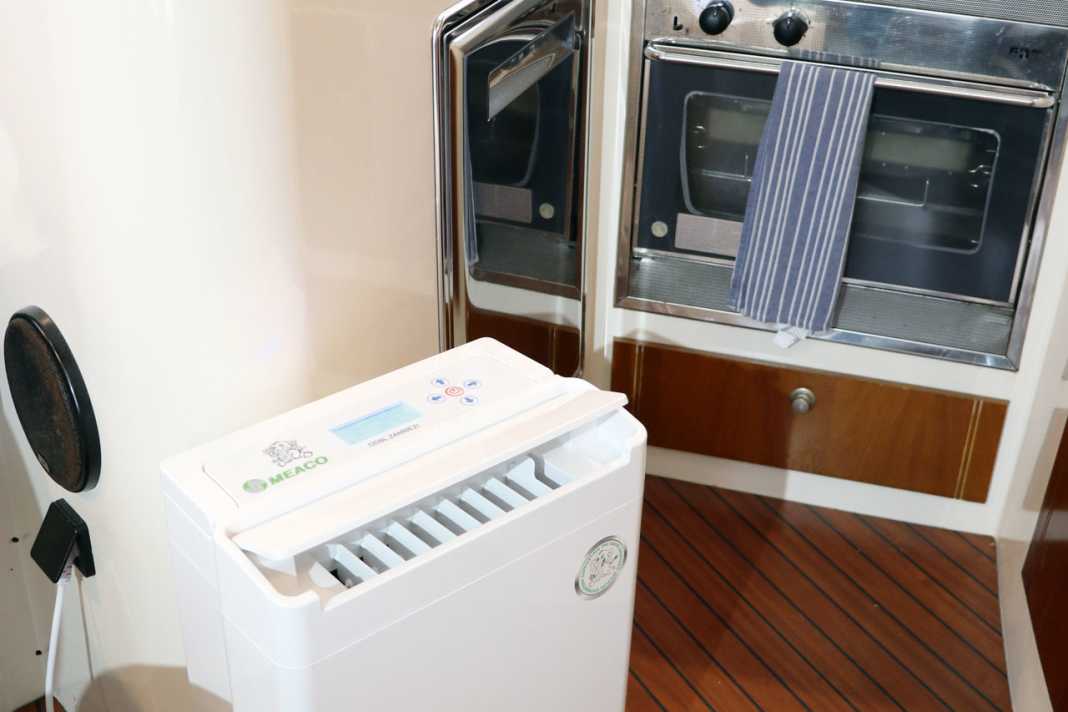





Further parts of the winter series:
During the summer months, the use of the boat usually ensures sufficient air exchange. This prevents an excessive increase in humidity and thus limits its destructive influence. In winter storage, however, it must be kept as low as possible using aids. Otherwise, the moisture can quietly cause uncontrollable sparks to creep everywhere and cause musty odours for months. This is difficult to remove from behind fixtures and panelling.
Textiles of all kinds are also at risk. Even under the best conditions, air cannot be exchanged in a wardrobe full of oilskins, even in summer. The result can be totally mouldy rainwear. In spring, leather items may be nothing more than lumps of mould. Vertical positioning of bunk cushions and seat cushions can prevent possible damage to their undersides, but not to the edges with which they now rest on their own.
Whether such problems become apparent in spring is only a question of climate. This is relatively easy to influence. As soon as the ship is ashore and all cleaning work with water on and in the hull has been completed, all water residues are therefore removed from the ship. And not only from all bilge sections and the engine bilge, but also from all storage spaces and other possible hidden corners. Sponges, absorbent cloths and household rollers are useful for this. Baby nappies placed in the bilge are also ideal.
Typical locations for moisture formation
This is also an opportunity to check where moisture could form and remain. Sometimes it is just the droplets of condensation that run down the inside of the side walls unnoticed. Moisture can also accumulate unnoticed under refrigerators or boxes. This is caused by poorly insulated or uninsulated pipe transitions into the cool box, where ice can form. This permanently causes melting water. Not only when the refrigerator is taken out of service after a weekend trip, but also when defrosting. If it remains undetected, it can also silently cause rot as soon as it keeps untreated wooden parts permanently damp.
Surprising amounts of condensation can also form on the outer walls of water tanks, especially those made of metal. Only when all absorbable water has been removed is the use of dehumidifiers effective in maintaining the lowest possible humidity. Water removal or, more precisely, air drying can be achieved by chemical or physical means. The former method uses hygroscopic granules that bind the water molecules and cause them to react. The resulting liquid must be collected. With the electrical method, the humid air is cooled down like in an air conditioning system and the condensation produced is also collected.
Various systems for air dehumidification
The hygroscopic method is the simplest and cheapest. Depending on the size and features of the collection system, there are a wide variety of brands and products available, some for less than five euros. The binding agent, a granulate in an air-permeable bag or in tablet form, is supplied in an airtight sealed package together with the collection container, which is usually nested inside each other to save space. The granules are available as a refill pack at a favourable price. The containers are usually sized to hold the entire amount of water until the granules are completely dissolved. These dehumidifiers are offered by many yacht equipment suppliers, but are also available in DIY stores or supermarkets.
Dry bags are a special form of this more passive air drying method. They contain granules of silica gel, which also remove moisture from the ambient air, but do not dissolve themselves. They can therefore be used several times by regenerating them under heat, for example at 175 degrees in the oven. Some dehumidifiers contain rock granules as a drying medium, which can also be regenerated in the microwave. Such dry bags can absorb up to 80 per cent of their own weight in water. They are somewhat more expensive than the granules that dissolve.
The electric method is the most effective way to get rid of moisture. Simpler devices are available for less than 50 euros. Although these dehumidifiers are quite powerful, their design limits their capacity. Once this limit is reached, they switch off automatically for safety reasons. The larger, more powerful ones with larger tank capacities also do this. However, as an alternative to the collection tank, some offer the option of permanently draining the condensation to the outside using a hose connection. If you search the Internet under the term "electric dehumidifier", you will find a huge selection of different performance levels and price ranges.
Timetable for optimum dehumidification
However, this active method of air drying requires a permanent power supply and means that an electrical appliance is operated in the boat without supervision in the long term. However, both are generally prohibited in professional winter storage facilities for safety reasons. So what to do? After thorough manual drying, the boat should be dried further for a short time using an electric dehumidifier with the lockers and storage spaces open. Then use the passive form of maintaining the optimum room climate created in this way. Mould and mildew then no longer stand a chance.
Incidentally, if you have taken care of your boat in this way, you do not need to ensure permanent ventilation. On the contrary, you should even close all hatches well so that no humidity can flow in from outside.

